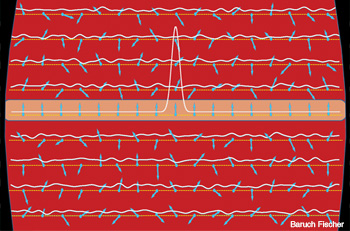Feature
Many-Body Photonics
Researchers are using statistical mechanics to uncover thermodynamic-like properties in optical systems. This unique research direction could have far-reaching implications for photonics.
 Let There Be Ordered Light: From random mode phasors (noisy continuous wave) to ordered mode phase (pulses). A laser cavity is full of entropy that can be viewed in the domain of modes (frequency) through the many phasor configurations (light-blue arrow arrays), or in the spatial or time domains through the many waveforms (white patterns) of light in the cavity. In a thermodynamic model, system equilibrium is not determined by the minimum energy (H), but by the minimum free energy F= H–TS, which includes entropy (S) and temperature (T). Nonzero temperature populates high-energy states that can be numerous (entropy), and therefore this dominates the equilibrium phase.
Let There Be Ordered Light: From random mode phasors (noisy continuous wave) to ordered mode phase (pulses). A laser cavity is full of entropy that can be viewed in the domain of modes (frequency) through the many phasor configurations (light-blue arrow arrays), or in the spatial or time domains through the many waveforms (white patterns) of light in the cavity. In a thermodynamic model, system equilibrium is not determined by the minimum energy (H), but by the minimum free energy F= H–TS, which includes entropy (S) and temperature (T). Nonzero temperature populates high-energy states that can be numerous (entropy), and therefore this dominates the equilibrium phase.
In photonics, quantum mechanics gets the glory—yet its cousin statistical mechanics can also play an important role in photonic systems. Many-mode lasers are prime examples. Passive mode-locking is an exact analogue of a first-order phase transition from disordered to ordered phase and active mode-locking maps to the known spherical model, which—in higher than two dimensions—has a second-order phase transition.
…Log in or become a member to view the full text of this article.
This article may be available for purchase via the search at Optica Publishing Group.
Optica Members get the full text of Optics & Photonics News, plus a variety of other member benefits.
